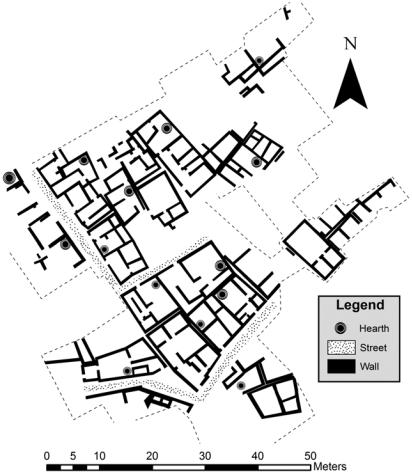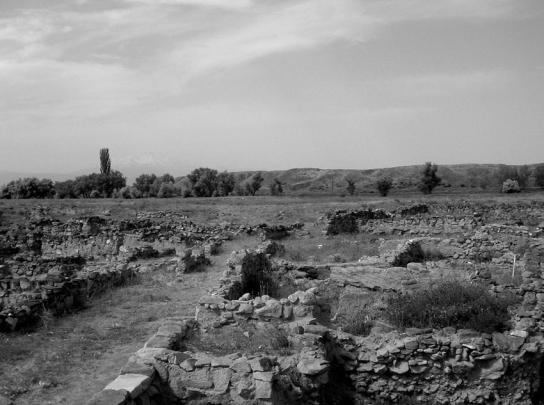
- •Preface
- •Acknowledgments
- •1 Introduction
- •The land and its water
- •Climate and vegetation
- •Lower Palaeolithic (ca. 1,000,000–250,000 BC)
- •Middle Palaeolithic (ca. 250,000–45,000 BC)
- •Upper Palaeolithic and Epipalaeolithic (ca. 45,000–9600 BC)
- •Rock art and ritual
- •The Neolithic: A synergy of plants, animals, and people
- •New perspectives on the Neolithic from Turkey
- •Beginnings of sedentary life
- •Southeastern Anatolia
- •North of the Taurus Mountains
- •Ritual, art, and temples
- •Southeastern Anatolia
- •Central Anatolia
- •Contact and exchange: The obsidian trade
- •Stoneworking technologies and crafts
- •Concluding remarks
- •Pottery Neolithic (ca. 7000–6000 BC)
- •Houses and ritual
- •Southeastern Anatolia and Cilicia
- •Central Anatolia
- •Western Anatolia and the Aegean coast
- •Northwest Anatolia
- •Seeing red
- •Invention of pottery
- •Cilicia and the southeast
- •Western Anatolia
- •Northwest Anatolia
- •Other crafts and technology
- •Economy
- •Concluding remarks on the Ceramic Neolithic
- •Spread of farming into Europe
- •Early and Middle Chalcolithic (ca. 6000–4000 BC)
- •Regional variations
- •Eastern Anatolia
- •The central plateau
- •Western Anatolia
- •Northwest Anatolia
- •Metallurgy
- •Late Chalcolithic (ca. 4000–3100 BC)
- •Euphrates area and southeastern Anatolia
- •Late Chalcolithic 1 and 2 (LC 1–2): 4300–3650 BC
- •Late Chalcolithic 3 (LC 3): 3650–3450 BC
- •Late Chalcolithic 4 (LC 4): 3450–3250 BC
- •Late Chalcolithic 5 (LC 5): 3250–3000/2950 BC
- •Eastern Highlands
- •Western Anatolia
- •Northwestern Anatolia and the Pontic Zone
- •Central Anatolia
- •Early Bronze Age (ca. 3100–2000 BC)
- •Cities, centers, and villages
- •Regional survey
- •Southeast Anatolia
- •East-central Anatolia (Turkish Upper Euphrates)
- •Eastern Anatolia
- •Western Anatolia
- •Central Anatolia
- •Cilicia
- •Metallurgy and its impact
- •Wool, milk, traction, and mobility: Secondary products revolution
- •Burial customs
- •The Karum Kanesh and the Assyrian trading network
- •Middle Bronze Age city-states of the Anatolian plateau
- •Central Anatolian material culture of the Middle Bronze Age
- •Indo-Europeans in Anatolia and the origins of the Hittites
- •Middle Bronze Age Anatolia beyond the horizons of literacy
- •The end of the trading colony period
- •The rediscovery of the Hittites
- •Historical outline
- •The imperial capital
- •Hittite sites in the empire’s heartland
- •Hittite architectural sculpture and rock reliefs
- •Hittite glyptic and minor arts
- •The concept of an Iron Age
- •Assyria and the history of the Neo-Hittite principalities
- •Key Neo-Hittite sites
- •Carchemish
- •Zincirli
- •Karatepe
- •Land of Tabal
- •Early Urartu, Nairi, and Biainili
- •Historical developments in imperial Biainili, the Kingdom of Van
- •Fortresses, settlements, and architectural practices
- •Smaller artefacts and decorative arts
- •Bronzes
- •Stone reliefs
- •Seals and seal impressions
- •Urartian religion and cultic activities
- •Demise
- •The Trojan War as prelude
- •The Aegean coast
- •The Phrygians
- •The Lydians
- •The Achaemenid conquest and its antecedents
- •Bibliography
- •Index
F O R E I G N M E R C H A N T S A N D N AT I V E S TAT E S
cosmopolitan with recognizable foreign influences, yet dominated by a distinctively Anatolian culture which was to outlast the mercantile activity by many centuries.
THE KARUM KANESH AND THE ASSYRIAN TRADING NETWORK
The key site for this period is Kültepe (ancient Kanesh or Nesha), located 19 km northeast of Kayseri and a little southeast of where Kızılırmak (the Halys River of classical texts) begins to curve northward through the plateau on its way toward the Black Sea. It is central to the history of this period both as the archaeological site that has produced the most textual and archaeological evidence, and as the commercial nucleus of the Assyrians on the Anatolian plateau. Kanesh served as the point of contact between Assyria and the rest of central Anatolia. It was but one of a score of polities of the period that we know by name, but it appears to have played a very strong political hand as the seat of a prince who ruled from a palace whose walls enclosed an area of more than one hectare. Significantly, the Hittites later named their own language after this site, although at this time many others were also spoken there.3 It is also appropriate to begin the discussion of this period with Kültepe since this site provides the basic stratigraphic sequence for ordering the chronology of the whole period.
The site of Kültepe is more extensive and complex than it first appears (Figure 6.3). What catches they eye is an approximately circular mound, roughly 500 m in diameter and rising 20 m above its surroundings. By itself, this is one of the largest mounds in Anatolia, but the lower lying areas that arc around its northern and eastern perimeters have produced the more spectacular finds. This lower area, off the main city mound, is known as the karum, or “quay” of Kanesh. The Akkadian word ka¯ rum was used to designate the harborside areas in Mesopotamian cities where trade was conducted, and although landlocked Kültepe was a port only for donkey caravans, the Assyrians applied the term to this merchant quarter and the institutions associated with it. Although we know from tablets that it contained a temple to the god Assur and an official building known as the bı¯t ka¯ rim (lit. “house of the karum”) what has been found there archaeologically is a collection of private houses in which both Assyrians and native Anatolians lived.4
It took some time for archaeologists to establish the precise source of the Old Assyrian tablets, although it was suspected they came from Kültepe from the time they first appeared in art markets in Istanbul and Kayseri in the late 19th century AD. The main mound attracted the passing attention of a number of archaeologists, including the renowned pioneer of Anatolian archaeology, Ernest Chantre, who dug there for two seasons in 1893 and 1894. Hugo Winckler, who achieved fame for his work at the Hittite capital, also excavated for about a week in 1906.5
These excavators were disappointed in their search for tablets, as was Bedrich Hrozny, the leader of a later Czech expedition, at least initially. The low quality of archaeological technique practiced by these early excavators did no small amount of damage to the mound. Hrozny, for example, was convinced that the palace in the center of the mound dated to the Hittite Empire,
227

F O R E I G N M E R C H A N T S A N D N AT I V E S TAT E S
Figure 6.3 Kültepe in Google Earth photo with karum and locations on city mound marked
and reasoning that the tablets must come from below because they predated the Hittites, dug right through it.6 We now know this palace in fact dated to the time when the Assyrians were active at the site. Despite starting in the wrong place, it was Hrozny who eventually discovered the karum. As his single field season of 1925 neared its end a local villager informed him that the clandestinely excavated tablets were not coming from the main mound at all but rather from beside it. Hrozny immediately transferred his workmen to the karum and was able to recover 1034 tablets in the time that remained.7
Work on a more archaeologically sophisticated level commenced at the site in 1948 with a Turkish expedition led by Tahsin Özgüç. It has continued in annual campaigns ever since, focusing primarily on the karum, but with some attention to the main mound as well. Özgüç, who directed the project into the 1990s, was able to work out the basic stratigraphy of both the citadel mound and the karum and provide the backbone of an archaeological chronology for Middle Bronze Age Central Anatolia. He discerned 18 building levels in the main mound, which are numbered from the top down. Levels 18–11 span the Early Bronze Age, and 5–1 cover the period from the Iron Age through the time of the Roman Empire. There is apparently no occupation in the Late Bronze Age, and the Middle Bronze levels, 10–6, represent the most prosperous period of the site.8 The karum was only occupied in the Middle Bronze Age, and has
228
F O R E I G N M E R C H A N T S A N D N AT I V E S TAT E S
its own stratigraphic sequence, normally designated by Roman numerals. The earliest two, Levels IV and III, are substantial, covering the whole area that was settled there, but have yielded no tablets. Level II is the most active period of the Old Assyrian trade and has produced the greatest number of tablets. References to Assyrian rulers and eponym officials9 date these from ca. 1920 to 1830 BC,10 with the great majority of the tablets probably coming from the second half of that span. This level was violently destroyed, which is no doubt how so many tablets came to be preserved. The karum was then abandoned for at least a generation. In Level Ib, dated by tablets to 1810–1740 BC,11 the trade was resumed, but at a lower level and on a somewhat different basis. Enough time had passed that the Assyrian language had actually undergone some changes, which tablets found at other Anatolian sites also reflect.12 Level Ia represents the much diminished and final occupation of the karum, without tablets.13
Publication of all the Kültepe materials, tablets and archaeological remains, has lagged, but the general picture is clear. All told, there are probably around 20,000 tablets from the karum, if one includes the ones from all excavations as well as those that turned up on the antiquities market. Alis¸ar, Bog˘ azköy and a few other sites in Turkey and Iraq have also produced a few hundred more Cappadocian texts. The catastrophe that ended Karum Kanesh Level II seems to have been local; all the Old Assyrian tablets from other sites belong to the Karum Kanesh Ib period, or perhaps a little later.
The tablets these Assyrian merchants left behind are valuable not just a source for the history of Anatolia in the 19th and 18th centuries BC, but also for what they have to tell us about ancient economics generally. Although they leave many things unexplained and are only part of a very large system, they provide the most detailed record of a long-distance system of trade that we have from the ancient world. They also give warning to archaeologists studying trade in other complex societies not to overestimate how much one can understand from material evidence alone. The commodities traded at Kanesh are for the most part invisible in the inventory of excavated objects, and without the tablets—which we would not have found had some more perishable material than clay been the writing material—there would be little indication that the Assyrians were here at all. In any case, let us begin with a discussion of the commercial arrangements, before broadening our horizons to the society as a whole.
What drove the trade, at least in the Karum Level II period, was the widespread demand for tin. Although bronze objects from the Early Bronze Age composed of copper and tin are not unknown and an inferior bronze was made by alloying copper and arsenic, the Middle Bronze Age is the first time that tin bronzes were produced in quantity. Turkey is rich in copper ores, but local tin supplies were apparently inadequate for the demands of the new era. We do not know precisely where the Assyrians were getting their tin since our documents only inform us about the commerce within Anatolia and between Anatolia and Assyria. It is clear, however, that the merchants of Kanesh were buying it in Assur and bringing it overland into Anatolia, where they were able to sell it for twice what they had paid. This presumably was the staple commodity that made local Anatolian princes so accommodating to these foreigners in their midst. Assyria, of course, did not have any tin of its own, and must have been importing it from elsewhere. It is
229

F O R E I G N M E R C H A N T S A N D N AT I V E S TAT E S
clear that the Kültepe texts are showing us only one leg of a larger trading network centered in Assur. The location of the mines that produced the tin is not known absolutely, but the direction of the shipments suggest that it was coming from the east, and the richest sources known in that direction are in the vicinity of Herat, in Afghanistan (Figure 6.4).
Tin was not, however, the most profitable trade item for the Assyrian merchants in Anatolia. Along with the tin, the donkey caravans making the 1000-km trek from Assur to Kanesh brought textiles which had been manufactured in Assyria and southern Mesopotamia. While it is hard to imagine there was any wool shortage in Anatolia, the tablets show that merchants, carefully weighing shifts in fashion and demand, made a gross profit of around 200% on textiles.14 Mesopotamian textiles may have been valued in the same way that Persian rugs are today. And what went back to Assyria? Despite all of the local goods which one would think the people living in resource-poor Assyria might want, the only thing the tablets show going back is money, that is, silver and gold.15 The discrepancy in the weight of material going in the two directions was so great that most of the donkeys coming in from Assyria were sold in Anatolia.16
Kanesh was the first stop for the caravans coming to and from Assyria, but it was only one of
Figure 6.4 Map of patterns of old Assyrian trade
230
F O R E I G N M E R C H A N T S A N D N AT I V E S TAT E S
15 sites in Anatolia to have a karum. Most of the others were in major cities of independent principalities, the most famous of which were Burusˇhattum (Purusˇhanda), Duhurmit, Hattusˇ, Ursˇu, Wahsˇusˇana, and Zalpa. Of these, only the location of the karum Hattusˇ is confidently pinpointed archaeologically, as it was part of the site of Bog˘ azköy, where the Hittites were later to establish their capital. Burusˇhattum, mentioned as a remote place in Mesopotamian texts of the third millennium, is generally felt to be one of the westernmost of theses merchant colonies, lying somewhere south of Tuz Gölü. An old Hittite story appears to locate one of the two places called Zalpa in the Old Assyria texts at the place where the Kızılırmak flows into the Black Sea.17 There was also a secondary, smaller type of trading center known as a wabartum. About a dozen of these are named in Kültepe texts, and they seem to have been located in smaller villages.
Assyrian merchants moved between all of these trading posts, apparently enjoying a kind of political neutrality, trading in a wider range of commodities (including copper) than they did on the Assyria to Kanesh route. A large part of the commercial economy of Anatolia was apparently in their hands. But the local palace was involved with, and benefited from the trade the Assyrians were practicing. Incoming caravans were first unloaded in the palace at Kanesh, before their goods went on the market. The king apparently had first choice of textiles brought to the karum, taxed the merchants, and could impose embargos. There is one commodity, of no small interest in the Bronze Age, which seems to have been of specific concern to the authorities: a metal known as asˇium or amu¯ tum, which had a value eight times that of gold. Since there are not many candidates for what so valuable a material might be, it is usually thought to be meteoric iron.18 It was rare, and its trade was restricted, if not prohibited by the authorities.19
The activities of these Assyrian merchants and their relationships with governmental authorities in Anatolia and Assyria are of great importance in a major debate in economic anthropology. Was the behavior of the merchants dictated by market forces that can be explained by such universal economic principles as supply and demand, or were these embedded in institutions that molded them into much more culturally specific forms that would defy such analysis? The economic historian Karl Polanyi, for example, argued that markets and abstract concepts of money—as opposed to special purpose money—were relatively recent inventions, and economic behavior in premodern societies could not be understood in terms of classical economic forces. His views had a great influence in the field of anthropology and at the time he was writing, in the mid-20th century, it was recognized that the data from Kültepe were crucial to this problem. Polanyi himself wrote an article attempting to demonstrate that the Old Assyrian merchants were engaged in treaty trade, where political agreements overrode the independence of individual merchants. More recent and detailed study of the tablets has shown this thesis to be untenable.20 The merchants bought low, sold high, looked for bargains, avoided what taxes they could, and assumed the risks for their ventures without any support from the palace on either end of the trade route.
At Kanesh, the karum was composed of private houses in which the Assyrian merchants as well as native Anatolians resided (Figures 6.5 and 6.6). There is no visible difference between the houses of the two populations—only the tablets establish the Assyrian heritage of some of the
231


F O R E I G N M E R C H A N T S A N D N AT I V E S TAT E S
Figure 6.6 Street in the Karum Kanesh, with city mound in the background (Photo courtesy Roger Matthews)
the tablets themselves and some of the seal impressions on them. The key figures in the trade, the Assyrian merchants, spent long periods of time in Anatolia—some of records suggest they stayed away from Assyria for decades—and adopted local customs. One letter, addressed to two merchants by creditors, laments: “Thirty years ago you left the city of Assur. You have never made a deposit since, and we have not recovered one shekel of your silver from you, but we have never made you feel bad about this. Our tablets have been going to you with caravan after caravan, but no report from you has ever come here.”21
The idea that Assyria had some sort of sovereignty or empire in Anatolia at this time no longer has any credibility, but the merchants did associate with one another and enjoyed certain special privileges. They had an assembly in Kanesh which served as a court and could impose punishments in matters concerning commercial activities and there was some sort of “house” or administrative structure to coordinate activities. The physical structures associated with these, however, have not been identified. The government of Assur maintained contact with the merchants of the karum through correspondence, and emissaries were sent to coordinate negotiations with the native Anatolian political authorities.22
233
